1st Position Blues Harp – An Introduction (Part 3)
A guide to straight blues harping
In previous posts we considered why 1st position blues can sometimes be left in the shadows. We also touched on building a general awareness of positional playing, how some positions are interchangeable, the Ionian Mode, the low end 1st position blues scale and some low end 1st position signature riffs.
One thing is certain; played well, the top register of the blues harp packs a mighty punch and it’s a crowd pleaser. Any blues harp player who likes to showboat will agree. John Popper of Blues Traveler rips it up with his quickfire high end licks. Sugar Blue blows us away in high altitude 3rd position, while Magic Dick blows the roof off with some soaring cross harp blow bends. In fact a long list of stars knock us down every time with their death-defying, high wire antics. However, it’s not only the fast stuff that delivers. Let’s enjoy a 1st position blues montage then get cracking again.
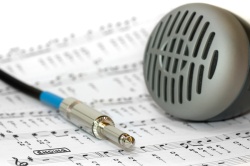 To the toppermost of the poppermost!
To the toppermost of the poppermost!
For the average cross harp blues player, established comfort zones are threatened when venturing into holes 7 to 10, which renders the new territory somewhat inhospitable. Firstly, all those neat blues patterns in the lower register are of little help because the reed layout in the upper octave is reversed. Then there’s the technique necessary to play accurate and controlled blow bends. And finally, there appears to be no bluesy way of connecting the two opposing ends of the harp, just a big old gap in the middle.
On today’s menu
We won’t dwell on blow bending technique in this post, as you can investigate this for yourself in our Harp Skills section. If you are not yet proficient, take some time out to master it, then come back and see how it can be applied. It will be time well invested. Meanwhile in this, part 3 of our guide to 1st position blues harping, we will explore:
• The high end blues scale
• Some high end signature riffs
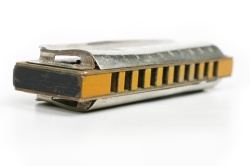 Technical note
Technical note
As you are well aware, blues harps come in a variety of different keys. Most top end blow bending, regardless of the position adopted, is played using a lower harp key. This is simply because the top reeds in lower key harps are marginally longer than in higher keys. Consequently they’re easier to control and more responsive to the levels of air pressure we can achieve most comfortably.
This is not to say that blow bends are completely impossible in the higher key harps, but the upper reeds are significantly more resistant and require an inordinate amount of work. Furthermore they can become extremely shrill and of relatively little reward to our audience. So our recommendation is to hone your blow bend skills on regular low harps such as G, Ab, A, Bb and perhaps B, or investigate customised harps such as a Low D, E and F.
Mapping it all out
Here’s the 1st position high end blues scale tab. The sound clip is played on an A major harp.
7B 8B’ 9D 9B’ 9B 10B” 10B
10B 10B” 9B 9B’ 9D 8B’ 7B
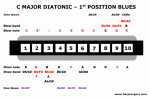 Now let’s look at a graphic of what’s going on. Click the image below to enlarge it or print yourself a copy here. All the safe notes have been highlighted in red. The great news is that, unlike the lower octave with it’s blues wannabe notes, we have a complete blues scale up top. You just need to master three important blow bends (8B’, 9B’ and 10B”) to crack it.
Now let’s look at a graphic of what’s going on. Click the image below to enlarge it or print yourself a copy here. All the safe notes have been highlighted in red. The great news is that, unlike the lower octave with it’s blues wannabe notes, we have a complete blues scale up top. You just need to master three important blow bends (8B’, 9B’ and 10B”) to crack it.
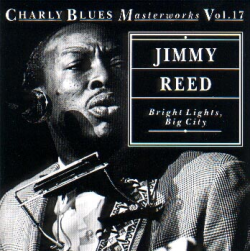 Honey knock your self out
Honey knock your self out
Now we’ve nailed the scale, let’s learn some high end signature blues riffs together. We’ll start with Jimmy Reed and Bright Lights Big City. You’ll need your A major harp.
Jimmy played almost exclusively through a rack mounted harp. Furthermore he played acoustically. To replicate his style, while the rack is not essential, you will need to adopt a laid-back, acoustic feel. Importantly, no hand effects are required.
Portamento, indicated by ~ in our tab, is the movement up from a bent note into a clean note and is a signature of Jimmy Reed’s delivery. In this number he also drops in 6D and 8D to mimic the vocal line.
..~8B ..~8B Spit technique can be used to trigger the 8B’
..~8B 8B’..7B..8B’..7B
..~8B ..~8B
8B’..7B 6D 8D 7B Echo the vocal line
..~8B..8B’..7B Over the IV chord now, so heavier on the 8B’
..~9B..10B
..~8B ..~8B
8B’..7B 6D 8D 7B Echo the vocal line
8B’..8B..8B’… Over the V chord now dig into the heavier 8B’
..~9B 10B ..~10B Keep that spit trigger going
..~9B..gliss..7B..7B Snag a few adjacent notes for that authentic double stop texture
Now you’ve tried this one out, investigate some more songs by Jimmy Reed. Honest I Do and Down in Virginia are two more classics. Be sure to nail his rolling, laid back feel. You might also want to check out the album On The Jimmy Reed Highway by Omar Kent Dykes and Jimmie Vaughan.
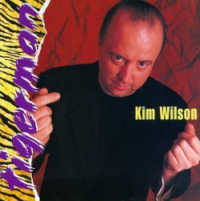 I have a right to trust my baby
I have a right to trust my baby
Let’s move on to another classic now, featuring Jimmie Vaughan’s old Fabulous Thunderbirds buddy, Kim Wilson. This example demands the highest standard of control on your blow bends. It’s that Sonny Boy II number Trust My Baby again, covered by Kim Wilson on his Tiger Man album. In Part 2, we tabbed out the low end intro lick to this number. Now grab your G major harp again and let’s look at that killer top end break.
By using a low harp key, the blow bends are more co-operative and relatively easier to hold. Nevertheless you will need to apply a large amount of air pressure to control and direct the reed movement.
The solo features a sustained 10B” vibrato, that famous glissando, a weeping harp and finally the standard jump to 2nd position over the V chord before returning to the lower register for end of the solo. There is another example of a sustained 10B” in the opening mix to this post; it’s played by Lester Butler of the Red Devils.
For the opening vibrato, you’re moving from a 10B” into a clean 10B, then easing back to the 10B” by maintaining plenty of air pressure. The vibrato is created by rapidly repeating this sequence. Control comes from a gentle movement of the upper-mid area of your tongue. You’re effectively applying and releasing a squeeze on the reed while pushing from your diaphragm. The repeated lick in the second line needs a punch at the start of each cycle. We call this a spit trigger.
..~9B ..~10B..10B”~……10B’…..10B portamento
9B’..9B..9B’..8B..7B a rapid repeat lick
9B’..9B..10B” 9B’..9B..9B’ weeping harp – milk it to the max
9B’..9B..9B’..8B..7B
[8B~9B]..[8B’~9B’]..[8B~9B] dipped trill
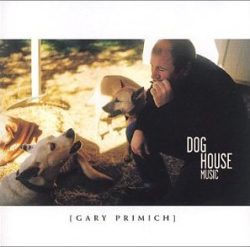
Bad boy barking at the moon!
Here’s a fine examples of 1st position top end Soul style harping. Gary Primich’s Dog House track from his 2002 Dog House Music album. Check out how Gary locks into the main melody, developing it in the same way a Sax player might. The phrasing that results is rhythmic and imaginative. Also, note how he hits those squawk notes, signaling in no uncertain terms that this is a harmonica break, not a horn break.
As an aside, consider how the harp break is somehow reminiscent of Junior Walker. In another series we will be exploring the harmonica’s role in Soul and Motown music. Borrowing from the great horn parts, as Gary Primich does here, and steering them into harmonica territory is an important part of this subject. But more of this another time. For now, grab your Bb harp and let’s get to work on Gary Primich’s solo.
..~9B ..~10B…………..
10B” 9B..9B’ 8B
10B” 9B’ 8B’..7B
(7B 8B’…8B 9B 8B..8B’ 7B 8B’..8B)
7B ..~7B–8B ..~7B–8B a hint of 7B for that squawk effect
7B ..~7B–8B ..~7B–8B
..~7B–8B ..~7B–8B 7B
..~7B–8B ..~7B–8B 8D
10B” 9B..9B’..9B
10B” 9B..9B’..9B
8B..9B 8B..8B’..7B
..~8B ..~8B
8B’..7B ..~8B
9B ..~10B 10B” 9B..9B’..8B
..~8B..9B ..~8B..7B
10D..9B ..~8B..7B
10D..9B ..~8B..7B
..~8B..9B ..~8B..7B
8B’..8B’ 7B
8B’..7B ..~8B ..~8B..7B
Note how Gary goes that extra mile to follow the chord changes. He tucks in two real gems – an unorthodox 8D and 10D. By including these two notes, the solo becomes more melodic than a standard blues. It’s more soulful and very pleasing to the ear. Now source the full track and see if you can figure out the song’s intro which uses similar licks.
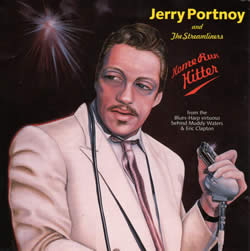 .. And I can hit ’em all night long
.. And I can hit ’em all night long
Finally, check out the high end break on this Harp Surgery house favourite by Jerry Portnoy, Home Run Hitter. Grab an A major harp and start work. As far as standard shuffles go, this one’s an absolute dandy. And as ever it’s down to Jerry’s tone, accuracy and attention to detail.
Now that you’ve mastered the art of blow bending and already tackled some examples above, this one should be within your bailiwick, as Jerry might say. Note how his cute roll down 10B..10B”..9B..8B’..7B is actually very similar to our series theme tune by Nine Below Zero (see below)
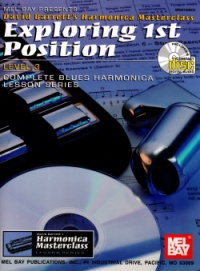 I can’t do my homework any more
I can’t do my homework any more
To close, we recommend you buy a copy of Dave Barrett’s book on Exploring 1st Position. It has a heap of practice riffs to work through that will develop your bending muscles! Dave also has books which cover 2nd and 3rd position. We also recommend Winslow Yerxa’s book Harmonica For Dummies as a neat way of exploring this feature of the diatonic harp. Check out our Music Store page for both these books.
In the fourth and final part of our guide to 1st position harping, we will investigate the missing link – how to navigate that big gap in the middle we keep referring to. We might even throw in a couple of extra 1st position tips along the way. Meantime back to Nine Below Zero to play us out.
Associated posts:
1st Position Blues Harp – An Introduction (Part 1)
1st Position Blues Harp – An Introduction (Part 2)
1st Position Blues Harp – An Introduction (Part 4)


Stevie Wonder does some very good top octave 1st position playing on the track “Boogie on Reggae Woman” (Ab harp)
Absolutely brilliant serie! 1st position understood. For the very first time… Thanks, Doctor.
Thanks Gazzer – what a fantastic reference. You’re absolutely right. Ab first position. And it may even have provided the inspiration for Gary Primich’s soul-funk style harping on Dog House. Thanks for a great piece of information.
Thanks too to you Sunnyside. Happy New Year! One more post-script article to go and the job’s done. Oh and maybe we’ll tab out that Stevie Wonder break from Reggae Woman!
Duster Bennett used 1st position very effectively on a number of tracks, my favourite is “It’s A Man Down there”
Hi Wilf, I’ve been battling away playing first position for about 6 months now and I’m looking forward to sitting down to study some of your recommended licks to put some structure around what I’m playing.
Are your still planning to complete first position (4)? I’ve been out in the blues desert and have learnt the 4, 5 and 6OBs but need some tips and licks to put the middle octave into context with the upper and lower registers. Strikes me that this is an academic pursuit, as no-one has ever really seriously taken this on.
David.
Hi David,
Thanks for your email. I have been meaning to finish the job for some time and your prompt is timely. Glad the earlier posts have been of value and well done for nailing those overblows. As you say, the final chapter involves largely unchartered territory. Which is an exciting prospect!.
The theory is reasonably straightforward, however the practical application is a different kettle of fish. Examples are not in abundance, but there are some. The majority of players take the traditional route, jumping registers and avoid the canyon as I am sure you know. Let’s hope we can help bridge that big old gap.
Hi Brian! Thanks for your tip. It’s a peach of a track and a perfect example of upper register 1st position. Duster was a massively talented player. The Blackjacks’ former drummer, Louis Borenius, once played with Duster.
Hi Wilf, I’ve given up the pursuit of the middle octave because it is just too hard. The first problem is that it take a bit of work to get a harp to play overblows and overdraws. I even got a harp from a harp customiser and the result is not much better than the stock harps I tinkered myself. The next problem is the mechanical difficulty of the OBs. They can be done but they can’t be done fast with 4, 5 and 6 all lined up in a row. Its all four-wheel drive in low range, the whole journey. Next problem is that the sound is thin. You can warm it up with tongue blocks but it will never be second position.
Which brings me back to second position. My original pursuit of first position began hoping to master the three octaves that are theoretically available. Most harp players are stuck on the second position middle octave. There is more! I’m finding most of the three octaves range also exists in second position. The lower octave is missing just the two bottom notes which are available back in the middle octave. The upper octave is available to those with the 6 OB and 7 OD. The 6 OB is a very useful note, not very hard to play and everybody should learn it. The 7 OD is a nasty piece and can be omitted. Even further up is the 10 blow and 10 blow bend which can be integrated back with the upper octave. So I have my three octaves but with all the chords and warmth in second position.
I learnt a few things from first position journey. Some first position runs are useful on the 12 bar V chord. I mastered the 6 OB along the way.
The only person I know who is actually playing the first position middle octave is Lee Sankey. Check him out. It is a unique sound but mostly inaccessible and avoided by nearly all harp player because it is just too hard.
I can play it but I just don’t see the point anymore.
David
Have done a rethink and just feel the need to add one more comment. The top end of first position blues can not be beaten. The blow bends are just sensational and there is no equivalent available in second position, where notes are mostly draw notes. The place for first position is to pull out your G harp (for a song in G) when the guy on sax gets going. Blow them all away with sensational top end then revert to second position, leaving the audience wondering where that all came from.
David
There’s no doubt those top end blows grab your audience every time. I just did a Whammer Jammer workshop for the National Harmonica League (UK NHL) and blow bends were of course an integral feature. Funny thing is that Magic Dick’s influence for using them came from the great Jazz horn players, not from other harp players. Nonetheless, check out the blow bends on the intro to Big Walter’s Hard Hearted Woman and I am sure that even Magic Dick would concede this must have lurked somewhere at the back of his consciousness. In his interview with Adam Gussow he mentions that Big Walter wasn’t his main harping influence – these were Little Walter and James Cotton – but he did get off on BW’s colossal tone.
Great feedback. Well the point is you’ve been there and come out a better informed player. Many others will never even think to try this. Ultimately while an ability to nail each position perfectly is an end in itself, the practical uses may be limited. I firmly believe in selecting the best ammunition you have for ‘sympathetically’ adding to a piece of music, like a classical artist. Rather than a blues graffiti artist. Consideration to the piece as a whole and what you can contribute as a musician (not just the harpman) are essentials. There is a strong debate ongoing currently on Harp-L about positional playing versus special tunings. Are tunings a cop out? Should we rely on one harp and labour over milking 12 positions from it? A quote from Sugar Blue has fuelled the debate. Check it out. Like the debate about puckering versus tongue blocking, personally I remain egalitarian. It’s all healthy and good. My microwave saves me time if I’m in a hurry, but preparing a really good meal with fresh herbs and imagination is a rewarding process for all.
You CAN play golf with just a 3 iron and a putter. But getting out of the sand trap is a b*tch.
Just looking at learning the harp. Found this site and have looked through it, looks good. It’s been awhile have you given up on part 4?
Hi New Kid – thanks for the reminder. One or two other projects seem o have interrupted the flow of things. I hope to finish this off very soon. Maybe check out a few other topics in the meantime ;o))
Did you ever complete part 4? Where can I find it? Many many thanks.
High Marc. All done – I hope you enjoy Part 4! Here’s the link… https://www.harpsurgery.com/1st-position-blues-harp-an-introduction-part-4/ Please share and pass the word.